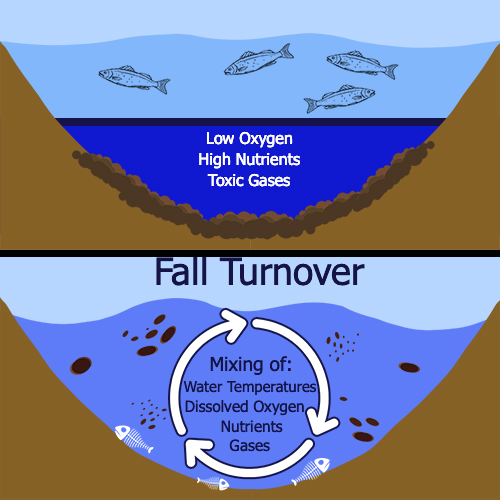Fall Pond Turnover and Seasonal Water Quality Changes
With the changing of seasons there are changes occurring within your pond. Some of these changes include vegetation dying back, shifts in water clarity, water temperature dropping.
The vast majority of aquatic vegetation will begin to die back in the fall. Free floating weeds like watermeal and duckweed begin to disappear from the surface. They've lost buoyancy and dropped to the bottom of the pond.
As plants decompose they release nutrients back into the water. While plants are breaking down they also consume oxygen.
Leaves fall into pond. Shoreline vegetation dies back and settles within the pond. All of this dead vegetation begins to slowly decompose into bottom muck. Accelerate breakdown of leaves and dead pond weeds with Pondzilla.
Water clarity can improve during this transition in seasons. As planktonic algae crashes, water appears clearer. When planktonic algae dies back, it also releases nutrients into the pond.
A water quality test can reveal the truth about water quality conditions. Custom treatment plans can be created to reset water quality back to safe levels.
Fixing Poor Water Quality
Most all-season bacteria treatments are effective to 38-50 degrees depending on brand. The colder the temperature, the slower the reaction and effectiveness of all-season bacterias. In addition, lower oxygen levels decrease overall effectiveness.
Apply WinterGard beneficial bacteria to improve water quality. This is a cold water bacteria for ponds and lakes. Wintergard is formulated to hit its peak performance when other bacteria treatments are beginning to slow down. Wintergard breaks down ammonia, nitrate and nitrite in water.
Apply treatments like Muck Remover and Phosphate Eliminator to reduce unwanted waste and keep water clean. Muck Remover remains effective in water to 38 degrees. Phosphate Eliminator has no temperature restriction.
Pond Turnover
Ponds that aren't properly aerated become separated into multiple layers. In summer months, warmer water remains at the surface. This surface water has higher dissolved oxygen. Deeper water is colder and lacks adequate oxygen. This is known as stratification.
As the water temperature drops in fall, water layers mix. This act of layers mixing is referred to as turnover. During pond turnover the oxygenated surface water mixes with colder low oxygen water from the bottom. As this mixing happens, oxygen levels can plummet. Fish can be caught in a zone with little to no oxygen. This mixing of water layers can also cause an influx of nutrients in the water column. If you heard of a fall fish kill, this is likely the cause.

Bottom aeration is the easiest option to reduce seasonal pond turnover. When pond water is circulated from bottom to surface, there isn't a separation of water layers throughout the seasons. Even distribution of dissolved oxygen reduces seasonal fish kills from the mixing of layers.

